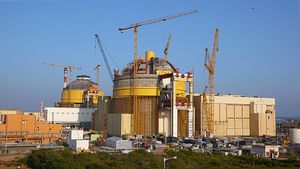The Kudankulam Nuclear Power Plant in the southern Indian state of Tamil Nadu has become the focal point of public debate in India over the pursuit of civil nuclear energy on a large scale. The run-up to the plant’s inauguration had been marred by protests from locals and the anti-nuclear lobby, who question the safety of the plant and have taken the issue all the way to the Supreme Court.
Kudankulam was originally envisaged in the 1980s. The Indian Department of Atomic Energy (DAE) chose the site despite the fact that it is situated in the environmentally sensitive Gulf of Mannar region. This was just one of the factors driving the mass protests over the years.
According to the IEA, more than 300 million people are known to be living without regular power supply in India. To bridge this massive deficit, nuclear energy is attractive for policymakers. However, the image of nuclear energy as a safe and clean option has taken a big hit in the wake of the Fukushima disaster in Japan.
Pre-Fukushima Japan was considered a model, along with the likes of Germany and France, of how to effectively implement nuclear energy and securing power supplies for a large economy. However, following the disaster and with the plant still not completely secure, Japan has been forced to forego its nuclear energy ambitions due to immense public pressure.
The outcome of Fukushima has also put the spotlight on the aggressive, globally active and well-funded nuclear energy lobby. For many in Tokyo, a disaster caused largely by a tsunami triggered by an earthquake in 2011 opened a can of worms over how the government regulated its nuclear backyard. This issue of regulation has gained momentum as more and more people question the conventional wisdom of nuclear energy being a safe bet.
The Fukushima disaster has yet to prompt a criminal investigation. But the Tokyo Electric Power Company, which operates the Fukushima Daiichi plant, has come under fire for not adhering to transparent management structures and for not appointing independent directors to offer non-biased perspectives in a crisis.
Efforts to clean up the Fukushima aftermath are still underway with no clear timeline as to when the plant and the surrounding area will be deemed safe. As part of the political aftermath, both the public and even some members of parliament belonging to the ruling Liberal Democratic Party in Tokyo have criticized the government’s handling of civil nuclear policies.
In India, even though plans for nuclear power remain unchanged, the Japanese example has turned further attention to the safety of such projects and has even given the government a boost on its stand over the heavily debated nuclear-liability law. In fact, a senior Planning Commission member recently mentioned how, during a presentation by French nuclear-tech manufacturer Areva SA, the company was asked why the Fukushima disaster happened. Expecting a more intricate explanation, all the Commission members got was that it was caused by “flooding” due to the tsunami. This bland description which began and ended with the tsunami event was not acceptable to the Commission, which was now looking for fool-proof methods of securing its nuclear power assets along with accurate and extensive case studies from the Japanese example.
According to author M V Ramana in his book The Power of Promise: Examining Nuclear Energy in India, some nuclear projects in India have come close to “disaster.” Other experts contradict this claim, pointing to a lack of evidence and reminding us of the fact that the difference between an “accident” and a “disaster” is significant. The fact that there is no clear record on accidents or potential disasters at India’s nuclear power plants raises important questions about the transparency of information on the issue.
This opacity in India’s regulatory structures in the nuclear energy sphere is something the DAE and senior officials in New Delhi will need to revisit at a much deeper level in a post Fukushima world. Appointments of independent regulators and directors working with the DAE and corporations will need to ensure that regulations are followed to the letter to avoid catastrophe. A nuclear disaster like Fukushima would have dire consequences in heavily populated India. Memories of the Bhopal tragedy, which killed an estimated 10,000 people in 1984, are still fresh, and so is the mismanagement of the fallout by the government of the day, including letting the senior management of U.S. firm Union Carbide escape scot free.
An audit of India’s Atomic Energy Regulatory Board (AERB) last year found irregularities in AERB’s mandates, which included worrying issues such as the agency not possessing enough power to oversee nuclear safety and security, failure of the board to develop a full and comprehensive safety policy, an order given to it in 1986, poor inspection rates, lack of formal procedures for decommissioning nuclear reactors, and other concerns.
India needs to move carefully in developing its civil nuclear industry and it should immediately begin setting up proper channels for communication on nuclear issues between the public and the state. Learning from Fukushima in both the technology and policy sectors is not an option for New Delhi; it is an absolute necessity.
Kabir Taneja is a journalist covering Indian foreign affairs and energy sector for The Sunday Guardian, The New York Times (India Ink), Tehelka, The Indian Republic and others. He is also a Scholar at The Takshashila Institution.
































